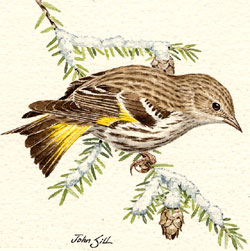Breeding Bird Atlases (BBA)
Find a Bird - BBA1
Breeding Bird Atlas 1 Species Accounts
Pine Siskin
Carduelis pinus
Egg Dates
May 9 to May 29
Number of Broods
one; possibly sometimes two

Like that of many northern finches, the Pine Siskin’s status in our area is unpredictable. In some years they are common and widespread during winter, and in others they are almost totally lacking. Their presence in the state during winter is usually the result of the failure of cone and seed crops in portions of the northern forest. In some years, migrants may pass through during October and November and return in April in small numbers as they move north to breeding areas.
During their winter stay here, they feed on the seeds of a variety of trees, including alder and birch. But the increase in bird feeding has had a profound impact on winter bird populations. This has been especially true for the small finches since the advent of niger thistle seed, a tiny black variety that they particularly favor. Feeders that are well stocked with thistle seed will often play host to numerous Pine Siskins for an entire winter. These circumstances have led to most recent breeding reports. Many of the northern finches are opportunistic breeders, capitalizing on a locally abundant food supply to ensure survival of the young.
Prior to 1970, there was a mere handful of breeding records for the Pine Siskin in Massachusetts. Early confirmations include a nest found in early May 1859 in Cambridge and another on May 29, 1883, in Newton. Scattered reports continued through the 1940s. Since 1970, breeding has become widespread in years when siskins are common in winter, with numerous reports in 1971. Nestings were “confirmed” during the Atlas period in several years, including 1976, and more than half of the entries on the map occurred in only one year, 1978. The map indicates that the Pine Siskin is apt to breed almost anywhere in the state, but there is a distinct bias for the greater Boston area where feeders abound. However, nesting is not limited to the immediate location of feeders because nests have been located at Mount Tom and in the wilderness of Quabbin.
Nesting evidence is hard to detect because siskins typically feed in small flocks even during the breeding season. One clue is long bouts of singing, beginning in March. The song is goldfinchlike, a jumbled assortment of twittering interspersed with a characteristic, sharply rising zzree note. Common call notes are represented as chee-ee and ti-er, with a tit-i-tit series, often given in flight. Courting males fly in circles around females and also feed them. Nest building generally commences in March or April and has been reported in the state as early as March 17. Females can be seen stripping bark from trees for the nest, which may also contain twigs and grass and is lined with a variety of materials including strands from old Fall Webworm nests, rootlets, and hair. Nests are well concealed in the branches of a conifer, usually above 8 feet. The female incubates a clutch of two to five (commonly three) eggs for about 13 days, during which time she is fed by her mate. Both sexes feed the young, which fledge in 15 days.
By early May, fledglings may be seen with adults at nearby feeders, and they are self-sufficient by the end of the month. Adults and young then generally depart, but occasionally flocks are noted as late as mid-June.
Map Legend and Data Summary
Atlas 1 data collected from 1975-1979


Note: very uncommon and sporadic breeder following flight years; prefers conifers for nesting
Richard A. Forster



